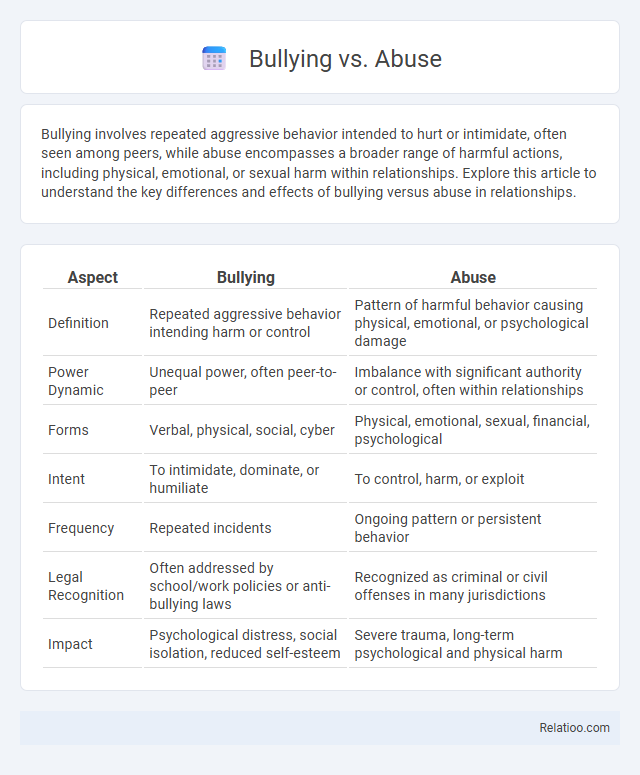Bullying involves repeated aggressive behavior intended to hurt or intimidate, often seen among peers, while abuse encompasses a broader range of harmful actions, including physical, emotional, or sexual harm within relationships. Explore this article to understand the key differences and effects of bullying versus abuse in relationships.
Table of Comparison
| Aspect | Bullying | Abuse |
|---|---|---|
| Definition | Repeated aggressive behavior intending harm or control | Pattern of harmful behavior causing physical, emotional, or psychological damage |
| Power Dynamic | Unequal power, often peer-to-peer | Imbalance with significant authority or control, often within relationships |
| Forms | Verbal, physical, social, cyber | Physical, emotional, sexual, financial, psychological |
| Intent | To intimidate, dominate, or humiliate | To control, harm, or exploit |
| Frequency | Repeated incidents | Ongoing pattern or persistent behavior |
| Legal Recognition | Often addressed by school/work policies or anti-bullying laws | Recognized as criminal or civil offenses in many jurisdictions |
| Impact | Psychological distress, social isolation, reduced self-esteem | Severe trauma, long-term psychological and physical harm |
Defining Bullying and Abuse: Key Differences
Bullying involves repeated aggressive behavior intended to hurt or intimidate someone physically, verbally, or psychologically, often occurring in settings like schools or workplaces. Abuse encompasses a broader range of harmful actions, including physical, emotional, sexual, or neglectful treatment, which may be perpetrated by caregivers, partners, or others in positions of power. Key differences lie in the intent, frequency, and context: bullying is typically repetitive and peer-related, while abuse is broader, can be one-time or chronic, and involves a power imbalance beyond peer interactions.
Types of Bullying and Their Impact
Physical bullying involves hitting, pushing, or damaging property, while verbal bullying includes name-calling, insults, and threats that affect emotional well-being. Social bullying targets relationships through exclusion, spreading rumors, or public humiliation, causing long-term psychological damage. Understanding these types of bullying helps you recognize the varied impacts on mental health, self-esteem, and overall quality of life.
Forms of Abuse: Physical, Emotional, and More
Forms of abuse encompass physical harm such as hitting or pushing, emotional harm including verbal insults and manipulation, and other types like sexual abuse and neglect. Bullying often falls under emotional or psychological abuse, involving repeated aggressive behavior intended to intimidate or harm a victim socially, verbally, or physically. Distinguishing between bullying and abuse requires understanding the intent, frequency, and power dynamics, with abuse being a broader category that includes various forms of maltreatment.
Recognizing Signs of Bullying and Abuse
Recognizing signs of bullying involves identifying repeated aggressive behavior such as teasing, exclusion, or physical harm that targets an individual. Abuse, encompassing physical, emotional, or sexual harm, often manifests through unexplained injuries, withdrawal, anxiety, or drastic changes in behavior. Differentiating bullying from abuse is crucial, as bullying tends to be peer-related and repetitive, whereas abuse involves a power imbalance and can be perpetrated by caregivers or authority figures.
Causes and Motivations Behind Bullying
Bullying stems from a need for control, insecurity, or a desire to assert dominance over others, often fueled by peer pressure or environments lacking empathy. Abuse typically involves a power imbalance rooted in long-term control or harm, motivated by deep-seated anger, trauma, or a need to exert authority. Understanding the distinct causes and motivations behind your experiences with bullying versus abuse helps identify effective intervention and support strategies.
Root Causes of Abuse in Different Settings
Root causes of abuse in different settings often stem from power imbalances, unresolved trauma, and social or economic stressors that trigger harmful behaviors. Bullying typically arises in group dynamics where dominance, peer pressure, and a need for control are prevalent, especially in schools or workplaces. Abuse, differentiated by its often systemic, repetitive nature, can be rooted in generational cycles, psychological disorders, and environmental factors like neglect or exposure to violence.
Short-term and Long-term Effects on Victims
Bullying often results in short-term effects like anxiety, depression, and social withdrawal, while long-term impacts may include chronic mental health issues and impaired self-esteem. Abuse, being more severe, can cause immediate physical injuries and psychological trauma, with persistent effects such as post-traumatic stress disorder (PTSD) and difficulties in forming healthy relationships. Comparing both, bullying mainly affects social and emotional well-being, whereas abuse encompasses broader physical and psychological damage that deeply alters a victim's life trajectory.
Legal Definitions and Protections
Bullying involves repeated aggressive behavior intended to intimidate or harm, often addressed through school policies or local ordinances without extensive legal consequences. Abuse refers to intentional harm or neglect causing physical, emotional, or psychological damage, with clear legal definitions and protections varying by jurisdiction, often involving child or elder protective services. Understanding the distinctions in legal definitions and protections helps you navigate available remedies and report incidents appropriately to safeguard your rights and well-being.
Prevention Strategies for Bullying and Abuse
Effective prevention strategies for bullying and abuse involve creating safe environments through clear policies, education, and early intervention. Implementing comprehensive anti-bullying programs in schools promotes empathy, conflict resolution, and awareness of abusive behaviors. Engaging parents, teachers, and community members in regular training enhances identification and response to signs of bullying and abuse, reducing their prevalence.
Support Resources for Victims and Families
Support resources for victims and families of bullying and abuse include counseling services, helplines, and community support groups designed to provide emotional assistance and practical guidance. Organizations such as the National Bullying Prevention Center and Childhelp offer specialized programs to address both psychological impacts and safety planning. You can access these resources to ensure confidentiality, legal advice, and therapeutic interventions tailored to overcoming trauma from bullying and abuse.

Infographic: Bullying vs Abuse
 relatioo.com
relatioo.com